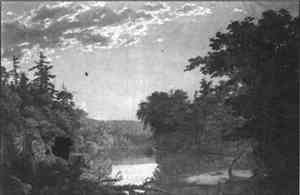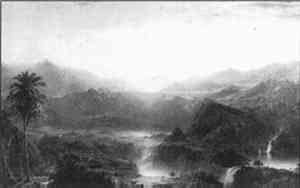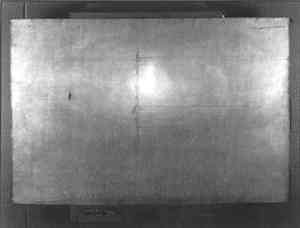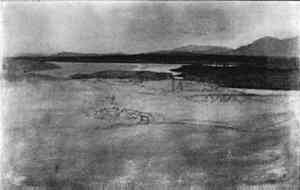FROM THE GROUND UP: THE GROUND IN 19TH-CENTURY AMERICAN PICTURESJOYCE ZUCKER
1 INTRODUCTIONBetween the teachings of the academies in Europe and the development of impressionism, American artists of the Hudson River School painted the beautiful, the picturesque, and the sublime. These artists were students of light (Huntington 1966), paintaing the “evanescent colors of dawn and sunset, the dramatic clear light of midday and the warm haze of Indian summer afternoons” (Stebbins 1983, 79), observing effects of atmosphere and the articulation of light. A painting that captures light is built from the ground up. The materials of the ground and the color of the ground both have a significant impact on the stability and tonality of the finished work of art. The dynamics of the ground influence the absorbency, permanence, and, ultimately, the quality of painting, light, and luminosity. This paper provides an overview of the use of grounds in 19th-century painting and uses the work of Frederic Edwin Church (1826–1900) to demonstrate the extent of change and the nature of some problems encountered with grounds in 19th-century American paintings. The materials of the ground have been identified by the use of the polarizing microscope or analytical transmission electron microscope and/or by analysis with Fourier transform infrared spectroscopy. The 19th-century marked a turning point for artists. No longer did they have to prepare their own canvases and grind their own paints, for as the century progressed, art supplies were more readily available from artists' colormen. Many artists' colormen had businesses in lower Manhattan near the Tenth Street Studio Building where Church, Albert Bierstadt (1830–1902), Sanford Gifford (1823–80), and many other artists shared both common space and a camaraderie in following a common pursuit. These artists were in and out of each other's studios, often viewing works in progress and learning techniques from one another. They purchased art supplies from the same group of vendors (Blaugrund 1987). At this time, a growing number of new, synthetic, relatively untried products were appearing on the market. Unfortunately, many products were adulterated, especially materials coming from England (Kemp 1990), causing the stability of artists' materials to be a matter of great concern. Manuals and handbooks of the period (Merim�e 1830; Bouvier 1844; Ridner 1850; Field 1869) provided advice on durability and tips on how to achieve translucency and brilliant color to maximize the potential for carrying light (Ridner 1850). In an effort to capture light and ensure permanence, the artists used translucent materials. Colormen used resins and vehicle modifiers (Carlyle 1990) to improve the working properties of the materials. In addition, they experimented with nearly every aspect of painting technique. Modifying recipes to achieve certain effects began with the ground layer. The colormen needed to provide a supple grounding for canvas that could be stored and rolled for long periods without apparent damage. The artists 1.1 THE IMPORTANCE OF THE GROUNDMax Doerner, an authority on painting materials, explains that the ground “has an extraordinary influence on the durability of the picture and the action of the colors.” He notes that a ground “makes the canvas more impenetrable and less porous and at the same time heightens the brilliance of the colors by means of a luminous ground” (Doerner 1984, 8–9). He goes on to say:
The great variety of grounds (i.e., oil, chalk, half-chalk) and their recipes have been discussed elsewhere (Hendy and Lucas 1968, 266–76) and are not addressed in this article. The ground not only provides a texture of the artist's choice and a level of absorbency and color but also serves as the structural layer between the fabric support and the paint. “The use of absorbent, semi-absorbent or non-absorbent grounds and the question of how to achieve the desired state of controlled absorption” (Hendy and Lucas 1968, 271) have much to do with the technical problems encountered in 19th-century American painting. In addition:
Balancing the right proportion of additives is extremely difficult. Therefore, it is not at all surprising that a variety of problems arose with commercially prepared canvas. In a letter to Asher B. Durand (1796–1886) dated May 24, 1836, Thomas Cole (1801–48) expressed his concern with proper primings:
Period treatises provide additional insight into the difficulties encountered by artists' colormen. Merim�e explained that “originally canvases were prepared like panels with distemper grounds.” He continued: “Size made of glove parings is laid on with a palette knife or trowel. When the size is dry, it is rubbed with a pumice stone. Then with a knife lead-white is laid on and pumiced. A second or third is also applied” (Merim�e 1839, 218). Merim�e noted that cloth prepared in this way required two or three months to dry in summer and five or six in winter. He also advised (220):
It was imperative that colormen find a proper grounding that would take less than six months to dry. Although Merim�e's suggested method offered an alternative shortcut procedure that added versatility, his system might have led to the kind of oil-stained canvas described by Thomas Cole. Experimentation continued, and the recipes and products produced varied in quality and type. While not a member of the Hudson River School, at the time the 1839 translation of Merim�e appears, the American artist John Vanderlyn (1775–1852) used what can be called an experimental canvas for his grid sketch of The Landing of Columbus, 1839. The canvas stencil (fig. 1) shows that this fabric was prepared by Valle and Bourniche. These Parisian artists' colormen had applied for a patent application in 1839 for primed linen canvas that would not react to changes in relative humidity. According to the patent, located with the help of the French Government Patent Office, the “active” ingredient was natural rubber (Valle and Bourniche 1839). They suggested that paintings that were to be hung on damp church walls be executed on this canvas for the achievement of long-term preservation. This example reveals the kind of experimentation being carried out by canvas preparers in an effort to develop a flexible, stable, primed canvas to meet increasing demand.
During such a period of change and experimentation, problems originating from the ground layer should come as no surprise. It is also likely that a variety of recipes for canvas preparation were being used and tested by the New York City artists' colormen and others. A basic recipe follows: “The canvas is first treated with size or a solution of glue….The priming consists of two coats, the first containing whitening and size, the second lead white and linseed oil” (Church 1915, 34–35). This recipe represents the most commonly encountered commercially prepared ground structure in 19th-century American paintings. Although ingredients used in the various layers change, invariably most recipes called for added drier in the upper layers to speed the drying time (Hubbard 1795; Hubbard 1939; Arteni and Posada 1984). It is interesting to note that a mid-century manual—a translation and compilation of European sources by the American artist, Laughton Osborn (1809–78)—asserted that canvas was universally used for pictures in oil. Evidently it was kept pre-primed in rolls of various widths at the colormen's shops. With short notice the canvas could be cut and stretched to any ordered size. Standard sizes were available off the shelf. The manual's writer urges that this ready-made canvas be 1.2 GROUND COLOROsborn was also specific about the color of the ground: “As to the tint given to this preparation, it is better that it should be light. Of the three kinds that are found in the shops, light grey, pink and the faintest flesh color, this last is the best” (Osborn 1845, 271). For landscapes, the specific recommendation for ground color is a warm and somewhat golden orange tint. If, however, the priming is grayish white, then a wash of a warm orange color is to be applied—brighter for the lights, darker for the darks. The gayest and brightest tone is selected for skies and distances (Osborn 1845). The fact that the warm colors will show through the upper layers of paint, enriching and harmonizing the colors on the surface is clearly understood. Bouvier (1844), in his influential treatise, recommended what he considered the best method for priming oil canvases. This method includes the use of a good, clear, rectified nut oil with lead-white of Holland, yellow ochre, and a little red ochre. He believed this method was “resplendent in light, not cold. It gives a harmonious warmth” (Bouvier 1844, 533). He did not ignore the use of pure red ochre grounds by the Old Masters but cautioned that pictures painted on this type of ground become suffused with brown in a relatively short time. In both Scene on Catskill Creek (1845) (fig. 2) and The Charter Oak (1847, Olana State Historic Site), Frederic Church used a technique similar to that of many contemporaneous artists. He worked on a white absorbent ground washed over with a warm imprimatura. Ground and pigment samples were mounted in Aroclor 5442 1.660 for optical analysis. Optical properties of the pigments were observed by polarized light microscopy (Zucker 1987). The layer directly against the fabric appeared to be primarily chalk (calcium carbonate) with a thinner layer of lead-white on top. In 1845, directly influenced by his teacher Thomas Cole, Church used the methods recommended by the influential treatises. Indeed, Cole's methods of preparing studies, sketches, and oil sketches prior to completing the finished painting are typical of European academic training (Boime 1986). In Scene on Catskill Creek, the imprimatura color changes from a light buff to a deep terracotta as we move from sky to foreground with four noticeable tonal changes. Using the Munsell Color System (Munsell 1976) to identify visual color and the Universal Color Language (Kelly and Judd 1976) to identify color names, the Munsell numbers and color nomenclature for the colors of
Huntington (1966, 63) observed that by the 1850s Church had abandoned Cole's “salmon buff” ground in favor of a thinly spread cream white ground. It has been suggested that Church's knowledge of Turner's use of white grounds may have motivated this change in technique. Church had John Ruskin's Modern Painters, which introduces the reader to Turner's methodology, on the bookshelves at Olana, his home. By the time, Church painted The Andes of Equador (1855) (fig. 3), he was using a two-layer ground, but the upper layer of lead-white contains a small quantity of bone black and raw umber to counteract the natural yellowing tendencies of lead-white in linseed oil. Church added zinc white at the sun to ensure a brighter white at this most radiant spot on the canvas. These pigments were identified from an unfinished canvas found in the archive at Olana State Historic Site (Zucker 1988)(fig. 4). The basic outline drawing had been laid in with chalk over the ground. This unfinished canvas appears to be the precursor for The Andes of Equador. The large-scale painting of The Icebergs (1861, Dallas Museum of Art) shows a two-layer white ground with a translucent blue-gray imprimatura and various translucent layers above (Thomas 1980). In Church's The Afterglow (1867) (fig. 5), the double-layer calcium carbonate and lead-white ground is found on both sides of the canvas (Zucker and Newton 1994). Church may have seen the double-sided ground as a measure to ensure permanence.
Unpublished conservation examination and treatment records were reviewed from the New York State Bureau of Historic Sites, Perry Huston and Associates, and the Cleveland Museum of Art to determine the components of the structure and grounds in Church's oeuvre. The thick, translucent, blue-gray imprimatura found on The Afterglow was used to carry and radiate light (fig. 6).
In Church's move to lighter colored grounds, he attempted to capture the brightness and luminosity of the white ground. The interposed translucent layers served to reflect and refract the light. Many other Hudson River School painters varied the color and type of ground. Ross Merrill, Jim Wright, Dare Hartwell, and Helen Mar Parkin reported in conversations with the author that Albert Bierstadt (1830–1902) used commercially primed linen canvas with primarily lead-white grounds (Hartwell and Parkin 1999). Later in his career, however, Bierstadt used a thin graphite ground on The Last of the Buffalo (1888, Buffalo Bill Historical Center) and (Hartwell and Parkin 1999). It is difficult to determine whether Bierstadt was interested in the preservative properties of graphite (it was said to impart waterproofing qualities) or in the ability of its silvery gray tone to produce the optical effect of the old masters (Doerner 1984, 30). In either case, graphite grounds had poor qualities as a substrate and produced poor adhesion with the layers above. J. F. Kensett (1818–72), another painter of the Hudson River School, also used commercially A period description of the working methods of Sandford Gifford (1823–80) reveals him working in a manner similar to Frederic
|






